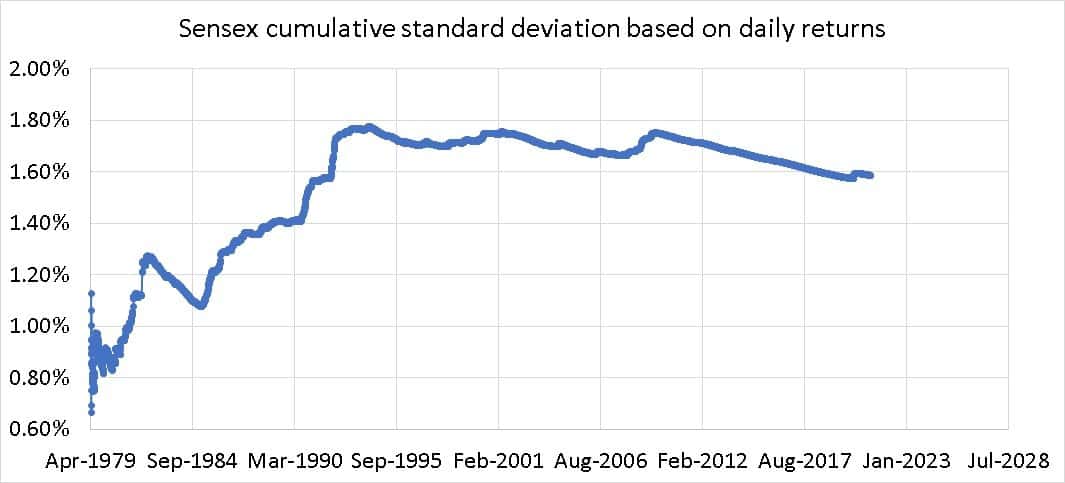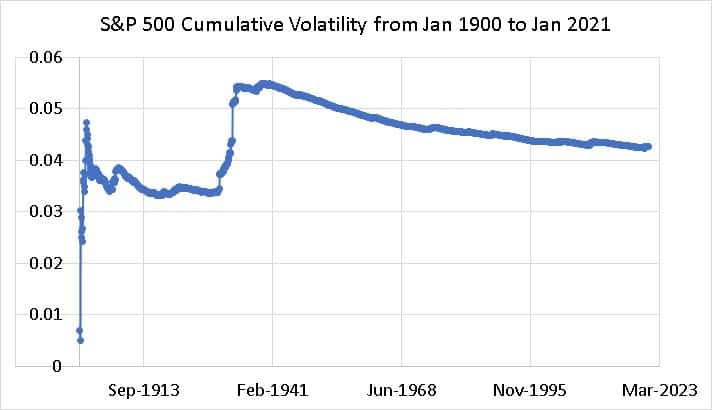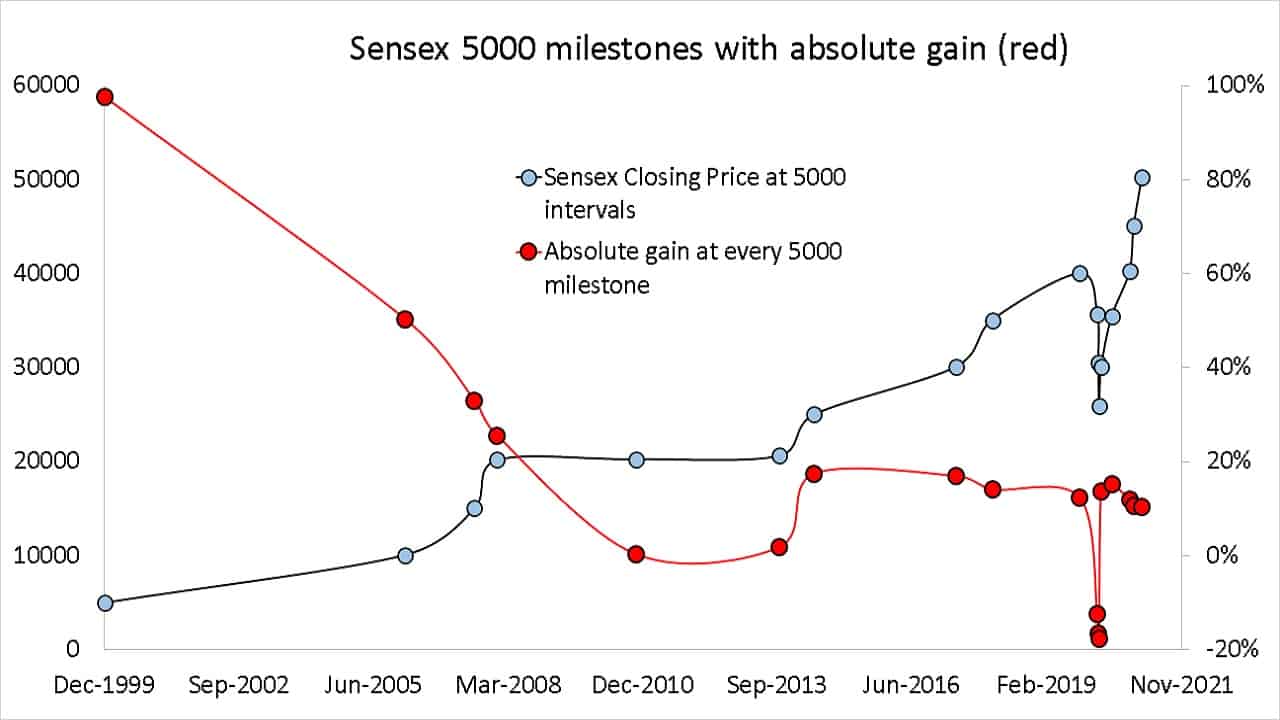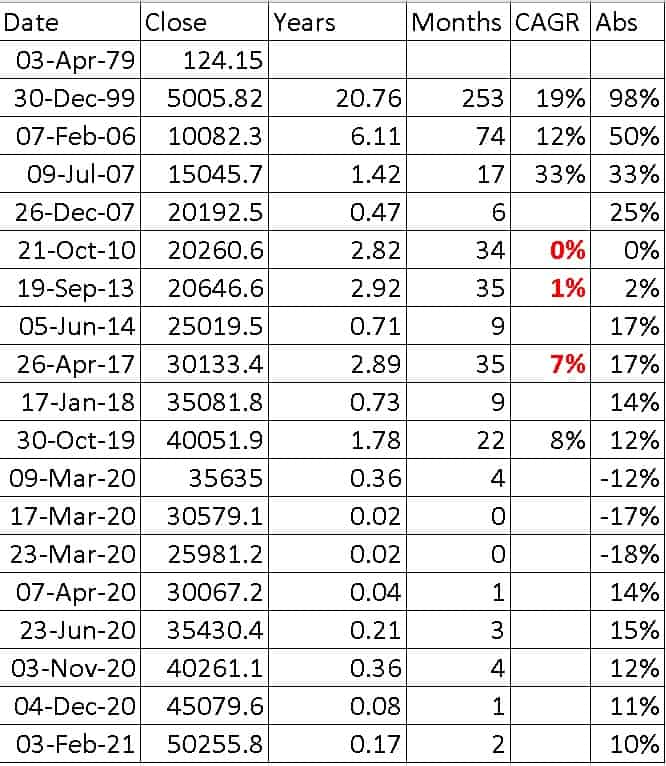Last Updated on December 29, 2021 at 6:03 pm
The Sensex closed for the first time above 50,000 on 3rd Feb 2021. We look at its 42-year journey for lessons on reward and risk.
The BSE provides closing price (excluding dividends) from 3rd April 1979 when the Sensex was 124.15. We shall use this data for analysis. Dividends will have to be added to all returns shown. This will typically be 1.5% to 2% extra return (before tax) occasionally falling to 1%.
Readers may recall this previous analysis with the same dataset: Sensex return is 16% plus over the last 41 years, but half of that came from just three good years! and Are you ready to climb the Sensex Staircase?!
First, we shall look at the Sensex move in log scale. Without the log scale, it is impossible to compare recement movements, for example, the 2020 crash with the 2008 crash or the Harshad Mehta scandal (see the Sensex staircase link for more explanation).
Join 32,000+ readers and get free money management solutions delivered to your inbox! Subscribe to get posts via email! (Link takes you to our email sign-up form)
🔥Want to create a complete financial plan? Learn goal-based investing? Exclusive access to our DIY tools? Increase your income with your skills? Enjoy massive discounts on our robo-advisory tool & courses! 🔥

The red lines indicate bull runs and sideways markets (including crashes). Notice how the steps (bull runs) have gradually decreased in slope, meaning lower returns during bull runs.
The horizontal lines represent the duration for which the Sensex was “underwater” – lower than an all-time high. The longest such line was during the 90s – India’s own “lost decade” and then after 2009 recovery.
We had discussed an idea called “volatility bunching” before – large up-moves will be followed by large down-moves or vice versa. Small up-moves will be followed by small down-moves and vice-versa. Read more: Timing the market will work but not the way we imagined!
A gradual reduction in daily fluctuations can be seen if we plot the cumulative volatility of the Sensex. That is the standard deviation based on daily returns. Notice the gradually fall in volatility with intermittent jumps since the Harshad Mehta days.

An investor with money in stocks since the 1980s would find the current volatility rather sedate or even insipid.
The same graph plotted for the S&P500 TRI since 1900 also paints a similar but smoother picture.

After the “great depression,” the cumulative volatility has been falling. Subsequent crashes look like minor blips!
Instead of the cumulative volatility, if we plot the rolling 10-year volatility, the result for S&P 500 TRI is astounding.

Over 10-year, the US market volatility has bee more or less the same except during the years of the great depression (the 1930’s). For the Sensex, this is how the 5-year rolling volatility looks like this (not enough history for 10-year data).

Still fairly high volatility and the 2020 crash is rather timid looking when compared to the Harshad Mehta scandal, the dot-com crisis and the 2008 crash! This despite the after biggest intraday, fall on 23rd March 2020! Conclusion: Indian market is relatively more volatile than the US market. If we take forex movement into account, the gap may widen. See the math here: Portfolio Diversification with International Stocks.
Shown below are the “5000 milestones” of the Sensex along with the absolute gain or loss from one milestone to another.

The table below shows the dates when the Sensex changed by 5000 points; the years and month it took for such change, the absolute gain or loss associated with this changed and the annualized return (CAGR) if the change took more than a year.

The recent frequent changes by 5000 points are hardly surprising because the baseline is higher. The first 5000 points increase obviously too the longest and since then it was the modern era of the Sensex (from the 2000s).
Even just a few years ago, we saw 5000 point gains taking 22 months and 35 months. Notice how the absolute gains do not reveal the true picture. They also tend to looky rosy such a movement. The annualised returns (excl dividend) highlights the importance of time. The longer it takes for the 5000 point move, the lower the annualised return—the money value of time at work.
You might have seen representations pointing to the “Indian growth story”:
The first 20 years, Sensex gained 5000 points and in the next 20 years, 45,0000 points. Three of the biggest 5000 point increases was see in the last few months etc.
This seems like a great growth story but if we consider the absolute gains for every 5000 point gain it reads 98%, 50%, 33%, 25%, 19%, 17%, 14%, 12%, 11%, 10%. So a 5000 point change in the Sensex is pretty much the norm and nothing to get excited about.
The only meaningful takeaway is the uncertainty associated with this 5000 point movement (up or down). Sometimes it takes less than a month and sometimes years. Volatility bunching will ensure gains or losses evaporate soon. It is the delay (range-bound markets) that will hurt investors the most because there is no such thing as “notional time loss”.
🔥Enjoy massive discounts on our courses, robo-advisory tool and exclusive investor circle! 🔥& join our community of 7000+ users!
Use our Robo-advisory Tool for a start-to-finish financial plan! ⇐ More than 2,500 investors and advisors use this!
Track your mutual funds and stock investments with this Google Sheet!
We also publish monthly equity mutual funds, debt and hybrid mutual funds, index funds and ETF screeners and momentum, low-volatility stock screeners.





- Do you have a comment about the above article? Reach out to us on Twitter: @freefincal or @pattufreefincal
- Have a question? Subscribe to our newsletter using the form below.
- Hit 'reply' to any email from us! We do not offer personalized investment advice. We can write a detailed article without mentioning your name if you have a generic question.
Join 32,000+ readers and get free money management solutions delivered to your inbox! Subscribe to get posts via email! (Link takes you to our email sign-up form)
About The Author
 Dr M. Pattabiraman(PhD) is the founder, managing editor and primary author of freefincal. He is an associate professor at the Indian Institute of Technology, Madras. He has over ten years of experience publishing news analysis, research and financial product development. Connect with him via Twitter(X), Linkedin, or YouTube. Pattabiraman has co-authored three print books: (1) You can be rich too with goal-based investing (CNBC TV18) for DIY investors. (2) Gamechanger for young earners. (3) Chinchu Gets a Superpower! for kids. He has also written seven other free e-books on various money management topics. He is a patron and co-founder of “Fee-only India,” an organisation promoting unbiased, commission-free investment advice.
Dr M. Pattabiraman(PhD) is the founder, managing editor and primary author of freefincal. He is an associate professor at the Indian Institute of Technology, Madras. He has over ten years of experience publishing news analysis, research and financial product development. Connect with him via Twitter(X), Linkedin, or YouTube. Pattabiraman has co-authored three print books: (1) You can be rich too with goal-based investing (CNBC TV18) for DIY investors. (2) Gamechanger for young earners. (3) Chinchu Gets a Superpower! for kids. He has also written seven other free e-books on various money management topics. He is a patron and co-founder of “Fee-only India,” an organisation promoting unbiased, commission-free investment advice.Our flagship course! Learn to manage your portfolio like a pro to achieve your goals regardless of market conditions! ⇐ More than 3,000 investors and advisors are part of our exclusive community! Get clarity on how to plan for your goals and achieve the necessary corpus no matter the market condition is!! Watch the first lecture for free! One-time payment! No recurring fees! Life-long access to videos! Reduce fear, uncertainty and doubt while investing! Learn how to plan for your goals before and after retirement with confidence.
Our new course! Increase your income by getting people to pay for your skills! ⇐ More than 700 salaried employees, entrepreneurs and financial advisors are part of our exclusive community! Learn how to get people to pay for your skills! Whether you are a professional or small business owner who wants more clients via online visibility or a salaried person wanting a side income or passive income, we will show you how to achieve this by showcasing your skills and building a community that trusts and pays you! (watch 1st lecture for free). One-time payment! No recurring fees! Life-long access to videos!
Our new book for kids: “Chinchu Gets a Superpower!” is now available!


Must-read book even for adults! This is something that every parent should teach their kids right from their young age. The importance of money management and decision making based on their wants and needs. Very nicely written in simple terms. - Arun.Buy the book: Chinchu gets a superpower for your child!
How to profit from content writing: Our new ebook is for those interested in getting side income via content writing. It is available at a 50% discount for Rs. 500 only!
Do you want to check if the market is overvalued or undervalued? Use our market valuation tool (it will work with any index!), or get the Tactical Buy/Sell timing tool!
We publish monthly mutual fund screeners and momentum, low-volatility stock screeners.
About freefincal & its content policy. Freefincal is a News Media Organization dedicated to providing original analysis, reports, reviews and insights on mutual funds, stocks, investing, retirement and personal finance developments. We do so without conflict of interest and bias. Follow us on Google News. Freefincal serves more than three million readers a year (5 million page views) with articles based only on factual information and detailed analysis by its authors. All statements made will be verified with credible and knowledgeable sources before publication. Freefincal does not publish paid articles, promotions, PR, satire or opinions without data. All opinions will be inferences backed by verifiable, reproducible evidence/data. Contact information: To get in touch, use this contact form. (Sponsored posts or paid collaborations will not be entertained.)
Connect with us on social media
- Twitter @freefincal
- Subscribe to our YouTube Videos
- Posts feed via Feedburner.
Our publications
You Can Be Rich Too with Goal-Based Investing
 Published by CNBC TV18, this book is meant to help you ask the right questions and seek the correct answers, and since it comes with nine online calculators, you can also create custom solutions for your lifestyle! Get it now.
Published by CNBC TV18, this book is meant to help you ask the right questions and seek the correct answers, and since it comes with nine online calculators, you can also create custom solutions for your lifestyle! Get it now.Gamechanger: Forget Startups, Join Corporate & Still Live the Rich Life You Want
 This book is meant for young earners to get their basics right from day one! It will also help you travel to exotic places at a low cost! Get it or gift it to a young earner.
This book is meant for young earners to get their basics right from day one! It will also help you travel to exotic places at a low cost! Get it or gift it to a young earner.Your Ultimate Guide to Travel
 This is an in-depth dive into vacation planning, finding cheap flights, budget accommodation, what to do when travelling, and how travelling slowly is better financially and psychologically, with links to the web pages and hand-holding at every step. Get the pdf for Rs 300 (instant download)
This is an in-depth dive into vacation planning, finding cheap flights, budget accommodation, what to do when travelling, and how travelling slowly is better financially and psychologically, with links to the web pages and hand-holding at every step. Get the pdf for Rs 300 (instant download)